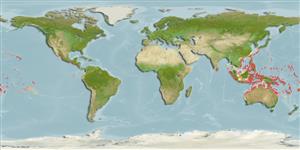Actinopterygii (ray-finned fishes) >
Perciformes (Perch-likes) >
Blenniidae (Combtooth blennies) > Blenniinae
Etymology: Aspidontus: Greek, aspis, -idos = shield + Latin, dens, dentis = teeth (Ref. 45335). More on author: Quoy, Gaimard.
Environment / Climate / Range
Ecology
Marine; reef-associated; depth range 1 - 25 m (Ref. 90102). Tropical, preferred ?; 32°N - 32°S
Pacific Ocean: Cocos-Keeling Islands (Ref. 9399) and Christmas Island (Ref. 30874) in the eastern Indian Ocean to the Line, Marquesan, and Tuamoto islands, north to southern Japan, south to New South Wales; throughout Micronesia.
Size / Weight / Age
Maturity: Lm ? range ? - ? cm
Max length : 11.5 cm TL male/unsexed; (Ref. 9710)
Dorsal
spines
(total): 10 - 12;
Dorsal
soft rays
(total): 26-28;
Anal
spines: 2;
Anal
soft rays: 25 - 28. Bears an amazing resemblance to the cleaner wrasse, Labroides dimidiatus. Distinguished from L. dimidiatus by the position of its mouth, which is terminal in the wrasse but under the snout in the blenny.
Adults are found solitary or in small groups (Ref. 90102) in lagoons, subtidal reef flats and outer reef slopes (where it occurs to depths of over 20 m). Often in pairs in empty worm tubes or narrow holes. They mimic the cleaner wrasse Labroides dimidiatus and nip fins, skin and scales of other fishes (Ref. 9710). They even copy the motion of the cleaner wrasse that may induce other fish to come close, then target their scales or mucus for a feed, biting and quickly retreating to the corals before the victim realizes that it was tricked; experienced fish recognize imposters and often give it a chase (Ref. 48636). Diet is supplemented with benthic invertebrates and zooplankton (Ref. 94105). Also feed on tubeworms and demersal fish eggs. Oviparous. Eggs are demersal and adhesive (Ref. 205), and are attached to the substrate via a filamentous, adhesive pad or pedestal (Ref. 94114). Larvae are planktonic, often found in shallow, coastal waters (Ref. 94114).
Life cycle and mating behavior
Maturity | Reproduction | Spawning | Eggs | Fecundity | Larvae
Distinct pairing (Ref. 205).
Myers, R.F., 1991. Micronesian reef fishes. Second Ed. Coral Graphics, Barrigada, Guam. 298 p. (Ref. 1602)
IUCN Red List Status (Ref. 115185)
CITES (Ref. 94142)
Not Evaluated
Threat to humans
Harmless
Human uses
Aquarium: commercial
More information
ReferencesAquacultureAquaculture profileStrainsGeneticsAllele frequenciesHeritabilityDiseasesProcessingMass conversion
Tools
Special reports
Download XML
Internet sources
